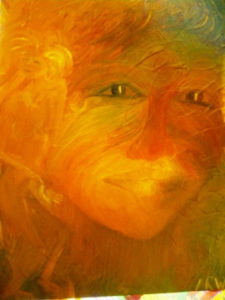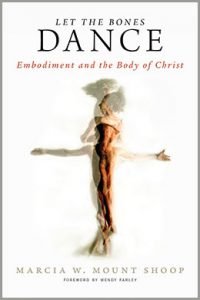By Wendy Farley
Marcia Mount Shoop takes us into territory mainline Protestants rarely go. She commits many and pronounced violations against Presbyterian propriety. She does not provide a nice, academic feminist critique of theological anthropology. She does not gently suggest we might be somewhat more inclusive in our worship. She uses her formidable academic training to tramp into our heads and hearts to set off one fire-storm after another. Both in her theology and in her writing style she engages in guerilla warfare against the disembodied, intellectualistic, fearful and homogenizing faith and practice of the Presbyterian Church. As myself a granddaughter, daughter, and sister of Presbyterian ministers, I read her with amazed and delighted wonder. Calvin himself could hardly have written more passionately or more provocatively as he called the church toward reform.
Bodies are not only fragile and vulnerable, they are also wildly diverse. With a delicate sense of the absurd beauty of all of God’s lovely, wise children, Marcia Mount Shoop displays the variety of bodies that bear Christ’s image. She gently reminds us that our anxieties imprison us in a sanitized homogenization. The spirited variations embodied by race, by wandering street people, by energetic styles of music and worship are denigrated or invisible. We betray the body of Christ when our fears defraud us of the adventure of welcoming more of the audacious beauty of Christ’s family into our own. We are embodied and our bodies are diverse, imperfect, suffering, interdependent sites of compassion and adventure. Our liturgy and our theology conspire to reinforce our fears that speaking the truth about bodies would be unseemly, inappropriate in God’s house. But what if God wishes to meet us precisely as we were created – embodied, suffering, confused, unique? “What if telling the truth really does set us free? What if living a lie really does afflict us?”

“Always Dancing” by Ani Rose Whaleswan, artist, survivor
Marcia’s energy is not primarily critical. She is determined to show us alternative ways of dwelling in our Reform heritage. Though deeply appreciative of the high value placed on intellectual honesty and education, she shows us that these values need not condemn us to a disembodied, passionless faith. A staunch defender of the principles of social justice that vivify Reform piety, she unveils a faith that is not only activist but contemplative, not only ethically committed but nurturing and joyous. Like the great nineteenth century theologian, Friedrich Schleiermacher, she insists that piety is not birthed in the intellect or as ethics, though it certainly must be expressed in these places. Piety is deeper than thought and will. It dwells in our bodies, in the pre-conscious formation of psyche and community. To convey this depth dimension of faith, Marcia borrows from Alfred North Whitehead’s analysis of “feeling:” not emotion but the pre-cognitive ground from which thought, emotion, memory, intention, commitment emerge. Few Protestant theologians have attempted to seek this pre-cognitive ground of our brokenness and of our healing. If she did nothing else in her book, her ability to provide a language for faith that is not reducible to belief and action, cognition and ethics would make the book indispensable for rethinking faith.
Because the book is in many ways so radical, it might be easy to miss the conventional structure that animates it. Marcia is a fourth generation Presbyterian minister. It is as if not only her education and liturgical formation but her cells and DNA bear witness to Reformed sensibilities. It is from thoroughly inside this tradition, by training and disposition and heritage, that she reconstructs it. Delving deeply into the basic structures of Reform thought, Marcia Mount Shoop refracts a theology of the human condition through bodily wisdom. Systematic theology typically juxtaposes sin and redemption. We look at the human condition once through the distortions of sin, original and actual, and a second time as this condition is transformed by the justification and sanctification of Christ. Marcia retains this pattern but inflates it quite differently. This double exposure of the human condition by sin and redemption receives its content from a repeating three-fold pattern. What Augustine might call “vestiges of the Trinity” structure the deep symbols of fall, redemption, and eschatological community that lurk under the surface of her re-embodiment of Protestant faith.
The first trinity is the witness from bodies that have been cut out of the theological conversation. What do bodies contribute to theology’s struggle to describe the human condition through the symbols of faith? Marcia chooses three aspects of embodied existence as prisms through which our common condition can be interpreted: tragedy, relationality, and ambiguity. These three aspects of embodiment define and structure our infinitely varied experiences. We suffer in ways that we find unspeakable. We are entwined with the lives of other beings as near to us as our own flesh and blood and as removed from us as butterflies stamping on the other side of the planet. We wish for neat and well defined situations and values but much of our experience turns out to be a mixture of good and evil, clarity and confusion, situations that delight and constrain us. These features of our lives are precisely ones that genuinely do shape human lives as deeply as anything possibly can and yet find little or no acknowledgement in churches. The witness of bodies is largely absent from church. The witness of women’s bodies is doubly so. To correct this, Marcia chooses to display these features of our lives through analysis of women’s embodied experience. Rape becomes the prism through which we recognize the condition of tragedy to which we are subject. Pregnancy becomes the prism through which relationality is explored. Motherhood becomes the prism that exposes the deep ambiguity we so often fear to acknowledge.
Having highlighted for us deep structures of our fate, she turns to Christ to see the pattern redemption writes over these inevitabilities. In the light of Christ tragedy, relationship, and ambiguity are not erased but they are transformed. Redemption opens tragedy toward a disposition of compassion. Relationship becomes interdependence. Ambiguity is back-lit by adventure. It would be typical of a Protestant theologian to leave it at that: sin and salvation described and defined with Christ as the door which opened from one to the other. But here, too, Marcia takes us in a little different direction. She does not stay with the individualistic frame which is implied in the excruciating concreteness of rape, pregnancy and motherhood. She moves with great exuberance from individual bodies marked by tragedy, relationship, and ambiguity to the corporate body. Redemption is not individualistic but communal. If it is as individuals that we struggle with the ambiguities of fate and tragedy, it is through community that we find redemption. T he healing body is the body of Christ.
A third trinity inspires the last portion of the book. Healing occurs in community and through liturgy. But it is liturgy in particular that presupposes and reinforces the delusion of disembodiment. The compassion, interdependence, and adventure that our bodies and souls crave are only imperfectly captured by the stiff and refined worship of “God’s frozen chosen.” Marcia reflects on confession, Eucharist, and music as dimensions of worship through which our difficulties might be acknowledged and our healing might be nourished. Confession might be not only acknowledgment of sin but an acknowledgment of our pain and difficulty. It might become a way to recognize how our fears block us from a fuller movement into the mercy and joy of God. Eucharist might become a place where Jesus dwells in us, not as perfectable beings but as wounded ones. We put our own bodies and the Body of Christ back together through this Eucharistic body. Music might expand, as it does in many churches, to include a variety of forms. Marcia quotes Calvin to remind us that we abuse God’s sacred name when our singing does not come from the deepest places of our heart. She imagines communities in which barriers of class, education, race, sexual preference, and aesthetic sensibilities might open up toward a new adventure of faith. She encourages us to drink deeply from our heritage: “this legacy of trusting God’s flame in each of us to guide us in a new song.”
A few years ago I happened to be visiting my parents a few days after their beloved church had burned down. An electrical failure as it turned out, but at the time there was some suspicion that it was related to the outsized, half crazy and decidedly un- Reformed homeless man who had been permitted to use the church facilities during the day. The congregation had just called a new minister who was in transit at the time. A liturgy was quickly constructed by the associate pastor together with a collection of other under-employed women ministers who were part of the congregation. That Sunday we sat on the church grounds facing the burned out carcass of the beautiful old church. The preacher wept all the way through her sermon, testifying to an unwavering commitment to justice and compassion whatever the cost. The songs and music moved in deep rivers of sorrow and consolation. The youth and children contributed their own expressions of grief and trust. In the midst of their own sorrow, the congregation prayed for injustices that created suffering much worse than their own. The congregation let its own grief flow even as it leaned on the divine mercy in trust and gratitude. I saw grown men – Presbyterian men – cry during the service. I had no idea a Presbyterian worship service could be like that. But it is a testimony to the liturgical and theological resources that grounds the Reform tradition. There is a deep embodied wisdom in the bones of this tradition and it is glorious to behold when it is given space to spring forward. Marcia’s book is both an inspired celebration of this heritage by one of its most dutiful daughters and an impassioned provocation that we live more adventurously, more fearlessly, more lovingly into this heritage.

